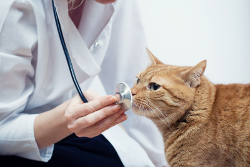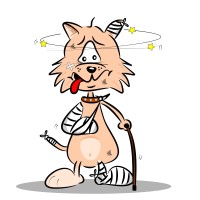One of the most common types of viruses that affects cats is feline leukemia (FeLV). It is a disease that damages a cat’s immune system and can lead to the development of various forms of the virus. FeLV can be transmitted from one cat to another by physical contact. The most common method of transmission of the virus is by the animal’s saliva and nasal secretions. Unfortunately, Feline leukemia causes the most deaths of indoor cats and can be contracted by any breed. Male cats have a greater chance of getting the disease than females. Feline leukemia usually develops in cats when they’re between one and six years of age.
Name: So why is it called “Feline leukemia”
FelV is a retrovirus that produces an enzyme that affects it which permits it to insert copies of its own genetic material into that of the cells they have infected. This process is similar to the effects of leukemia. The name was created because the virus that caused the disease was considered a form of leukemia. When it was realized the virus was not related to leukemia, the description remained. The name stuck and it’s how the virus is referred to by both pet owners and veterinarians.
Types and Symptoms
The kind of feline leukemia infection that your cat has received will be determined from a variety of infection types. There are three different categories of infection; FeLV-A, FeLV-B and FeLV-C. A cat can suffer with one, two or all three forms of the virus. FeLV-A develops in all cats that have been infected and It damages the cat’s immune system if untreated. FeLV-B develops in about half of the cats who are infected. It will result in a cat experiencing different sized tumors and different kinds of irregular tissue growths on its body. FeLV-C is the rarest form of the disease. Less than 1 percent of cats develop this variety of the disease. FeLV-C causes a cat to develop severe anemia.
A cat that may have contracted the virus could exhibit some of the following signs:
- A loss of appetite
- Damaged fur
- Problems with their pupils
- Seizures
- Dramatic weight loss
- long term Fever
- Abortion of kittens (if pregnant) or other reproductive failures
- Persistent diarrhea
- Enlarged lymph nodes
Once a cat has been infected, it may be able to successfully battle the disease and develop an immunity to it. Some cats remain in good health but are a carrier that will display no symptoms for several years if ever. Some cats become infected and only develop a damaged immune symptom.
Diagnosing
When it comes to diagnosing feline leukemia, the infected cat will have to be exposed to a symptomatic carrier for approximately a month or longer for it to be detected from a blood sample. After about five months of constant exposure around 80 percent of cats will develop symptoms of feline leukemia.
Initial tests will include blood work, urinalysis and chest X-rays. These tests may or may not reveal any problems. The testing may also show anemia or a low-grade urinary tract infections, abnormal tissue growths or fluid mass.
If a veterinarian suspects a cat has the virus after initial testing, they can then perform a test to confirm their suspicions. There is an ELISA (enzyme-linked immunosorbent assay) test that can be done with a cat’s tears, saliva or blood. This test is able to identify cats that are at the early stages of the virus.
Another test called IFA (indirect immunofluorescent antibody assay) analyzes a cat’s blood or bone marrow. This is done after the ELISA test is performed and will identify the stage of the infection. Unfortunately, Cats that have a positive IFA result typically do not have a good long term survival rate.
Treatment
There is currently no treatment for feline leukemia that is completely effective. The United States Department of Drugs and Alcohol (USDA) has approved a treatment for cats with feline leukemia called LTCI. It is a natural protein that helps a cat improve its ability to battle infections. Also an approved European treatment called Interferon-ω (omega) has been effective in improving in mortality rates when used on in treating cats infected with FeLV in a non-terminal stage.
Prevention
The main way to have an uninfected cat avoid contacting the virus is to contact a veterinarian and have it vaccinated against the disease. The vaccines administered each provide a different level of protections.
If cat owners also follow some simple rules they can decrease the chances of their pets getting the virus. Every cat in the household, even if it’s the only cat, should be tested. Viremic cats are felines that carry the virus, but do not suffer any of the symptoms. Any cat diagnosed as a viremic cat should be removed from a home or quarantined. All contact with any viremic cat should be avoided by uninfected cats. Anything a cat comes in contact with on a regular basis such as dishes, bedding and litter boxes should be disinfected regularly. Interaction with other cats, especially cats with no owner, should be prevented. Cats that spend time in the outdoors should be tested every three months. Cat owners should be careful make certain their pets only breed with other cats that don’t have the virus.



Comments are closed.